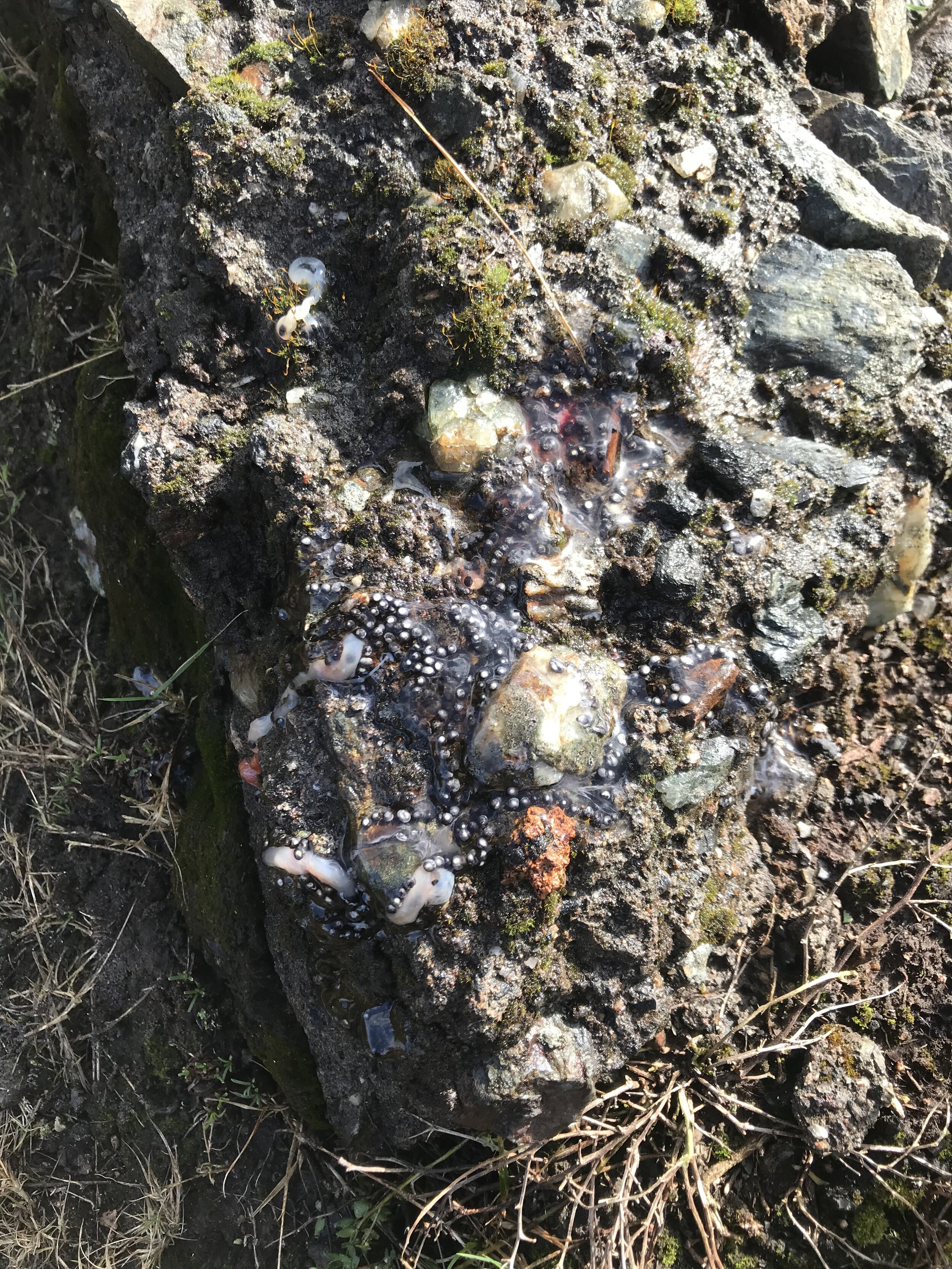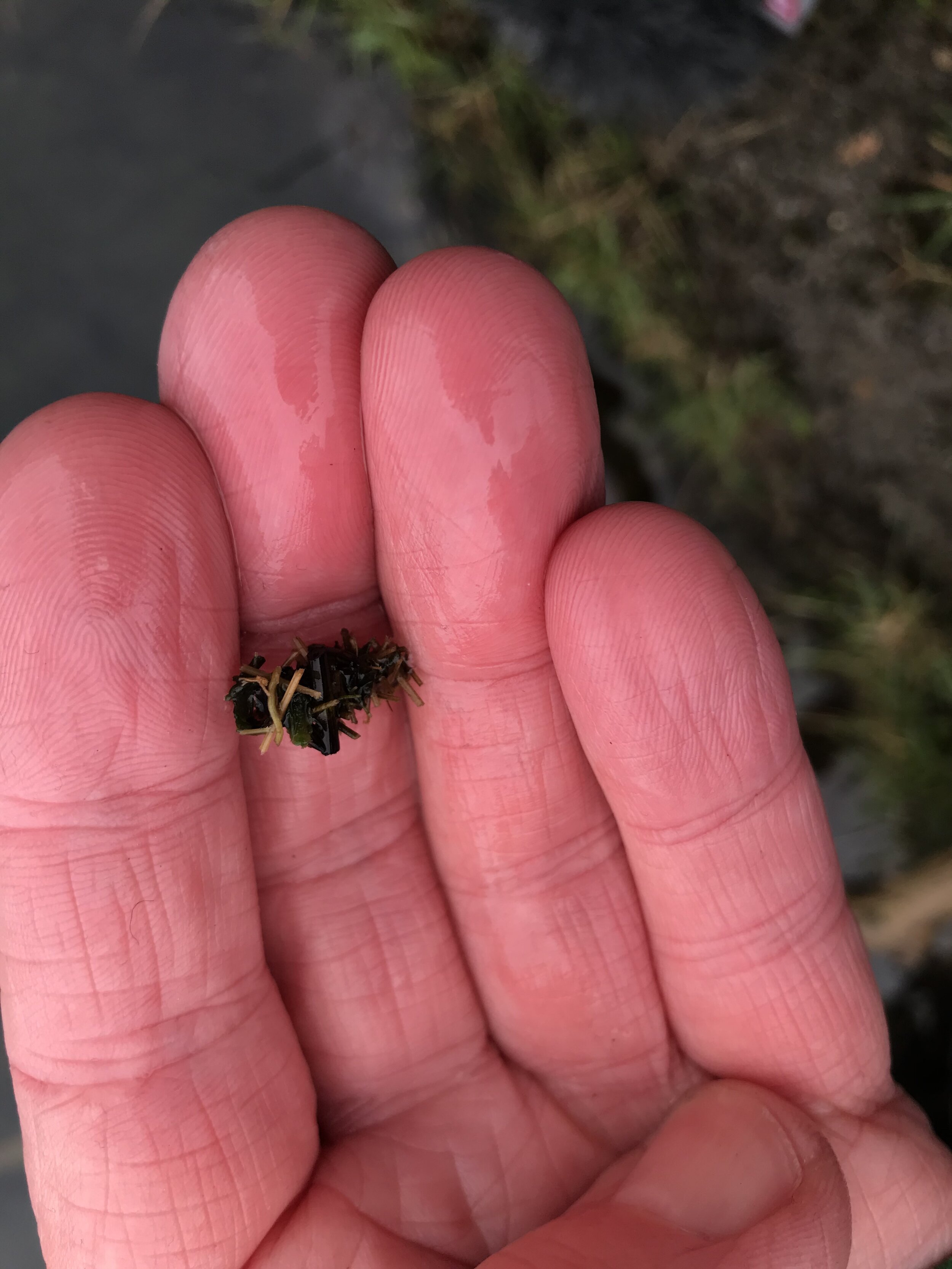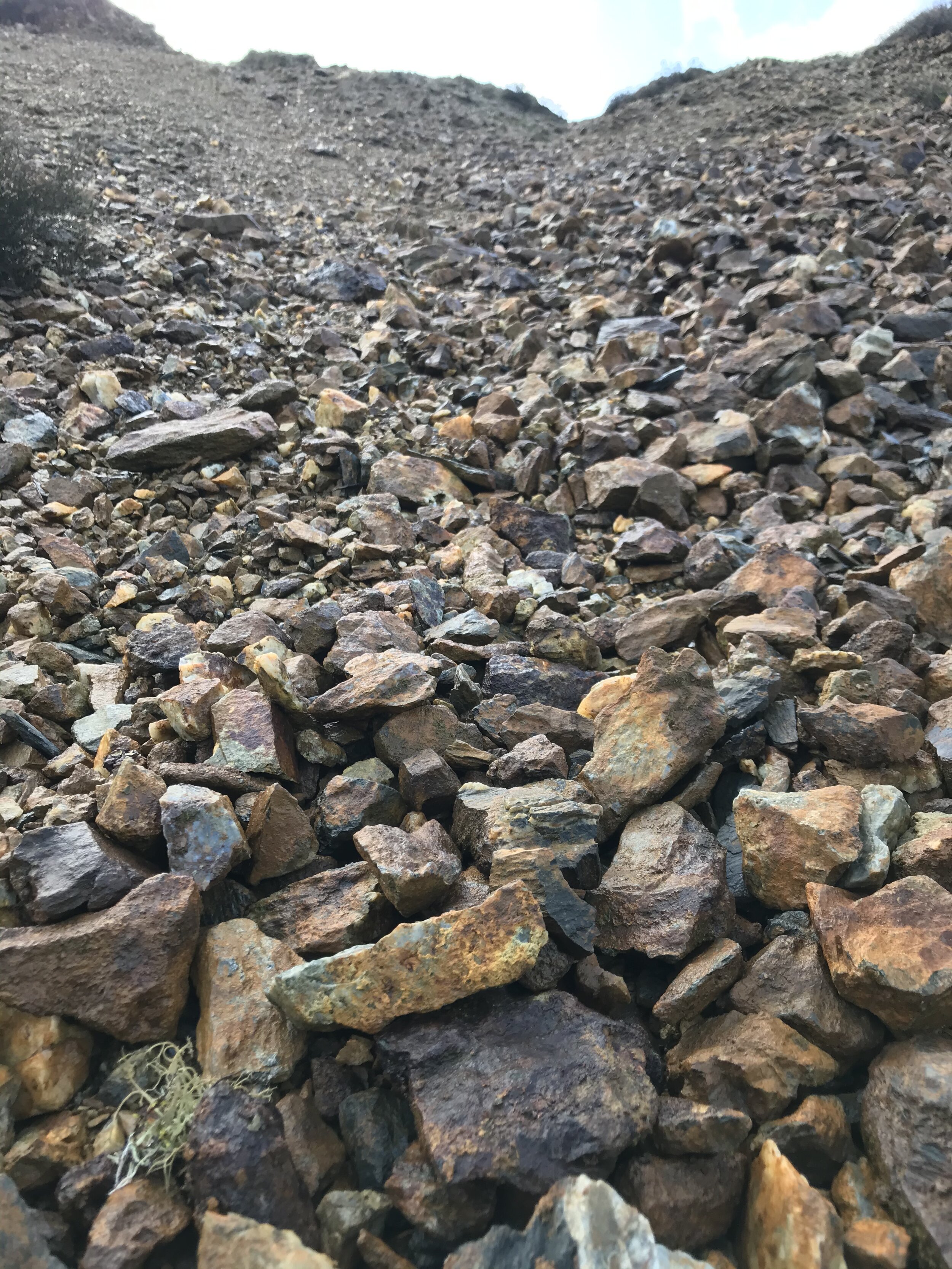MINERAL WONDERLAND
‘It looks dead, but it’s not; it’s a long way from dead,’ says Steve. We’re gazing into one of the many settling tanks of the old tin-streaming works at Great Wheal Seton, in the shadow of the A30. The pondweed in the tank of shallow water is covered with a hoar-frosting of blue-white mineral sediment. It’s beautiful and strange, as if we were gazing down from a great height on a snow covered pine-forest. The tank is about fifteen metres long by three metres wide and makes use of the slope of the hillside in a way that reminds me of the manmade tide pools you can find on some Cornish beaches. Clear water still flows in at the upper end where a sluice would have been, but its motion through the body of water in the tank is barely perceptible. Rain falls on its surface, plucking and warping it like a section of space-time, making clear that what we’re seeing is not eerie white sludge, but the light reflecting off it.
The sediment is the copper equivalent of acid mine drainage; a mineral oxide that precipitates out of water and smothers everything. Stir it up and it’s like curdled milk. But life is thriving in this mineral snow-cheese; the sediment’s density and chemical make-up has retarded the succession of vegetation you’d expect on an abandoned site like this, a succession that would usually choke off the breeding areas of early colonisers like the dragonflies and damselflies which are Steve’s passion. In the case of the Scare Blue-tailed damselfly, for which this site is famous amongst dragon-fly enthusiasts, the precipitate ensures room for the fine, short shoots of the plant the Scarce Blue-tailed needs in order to climb from the water and launch into air.
In the centre of the tank, a clump of frogspawn has been transformed to a pearly opalescence by the sediment, like a cluster of grapes taken from a freezer and placed in a humid room. Or ghostly bath pearls. The tank veers between forest and pond as we wonder over the intrusion of spawn into this wintery submerged scene. What is natural—frogspawn in a pond in March—here seems alien. Here, it’s not possible to establish any kind of boundary between the natural and the unnatural, should one want to do so. The settling tanks at Great Wheal Seton form a mosaic of different depths of water, different velocities of flow, different opennesses, with each slight difference attracting different species to take advantage of niche opportunities. It may look a bit of a mess and not be everyone’s idea of a beautiful landscape, says Steve, but it’s one of the richest sites in terms of biodiversity along the banks of the Red River. It’s all manmade; or, rather, shaped by the human species’ interaction with other species.
To me it’s like a dream come true. It’s quietly thrilling. The white-blues, the red-ochres, the pulse and stillness of water, and the sense that we’re in a ruin haunted by carbon intensive, extractive industrial forces. When planning the project I’d rewatched Andrei Tarkovsky’s film Stalker; and more recently I’ve seen a brilliant exhibition of his work at The Eye in Amsterdam. I knew he was important to me; that the Red River valley might prove to be analogous to The Zone. And now it was there in front of me, dissolving me into its resonances. The washes of film, dream, vital presence and haunting absence, resolved themselves in the settling tanks. Their volumes seemed to occupy all my thought; to hold me. I was in my own drowned foundations, water sanctifying the unhallowed ruins of a mysterious institution. Where, in Tarkovsky, water will wash over the tiled floor of a derelict building, fructifying, altering and incorporating the haunted space into its body of light, I had water pulsing slightly over deltas and forests of mineral sludge; over old augers, cogs and water-sodden wood from rotten sluice gates. I wanted to lie down like Stalker and feel the water around me both as a continuum with my blood and with my dream of being interfused with the world; to become again what I always am.
*
With the tip of my knife, I tease apart the fox turd we’ve found on one of the low walls of the settling tanks. It’s packed with tiny bones unfolding back into the scurry and hunt of the night: a crush of little white wishbones. Further along, we look for the snake skin Rob spotted in some clumps of heather: it turns out to be a muddy rag of synthetic fibre printed with diamond-shaped pattern of sequins. Then, a glitter of blood and viscera on stone looped with necklaces of toad spawn: something has taken the toad and left the spawn behind because, as Steve explains, spawn expands on contact with water; and you don’t want spawn trebling in size in your guts while you’re trying to fly off. Whatever took it knew what it was doing.
Rob stops to listen to the Red River. I love these pauses where we all have to go quiet while he listens to some ordinary thing with his fluff-hooded microphone. It’s as if he were sanctifying quietness and allowing the acoustic world to bristle back into detailed texture as his boom dips towards its subject: a bike without a silencer echoes off the A30; general traffic surf; a blackbird; sparrows in brambles; the Red River racing on and on in its narrow manmade channel, rags of plastic from the storm drain caught in overhanging branches.
I climb up the hillside to look at the spoil heap on which nothing has grown. It’s a rusty red scree slope, its brittle wet mass immense; like a lava flow that’s pushing the forest of gorse in front of it away, although it hasn’t grown in length for nearly a hundred years. Down below me, the geometry of the tanks becomes clear: a grid of concrete, sprigged with vegetation, framing windows of differently-coloured and populated water. I can see Steve has returned to the ‘little forest of stick houses’ that are the caddisfly larvae. He looks like a child over a rock pool. No wonder: he used to play here as a child, exploring the now-demolished buildings, running through tunnels, jumping into settling tanks, playing at the Second World War. Later, he taught himself how to read the ecology of the river and its catchment. He’s been through the Tolvaddon culvert. I want to go through it! Perhaps we’ll go through it together when the water drops, we tentatively agree. As I look down from the spoil heap on Steve and Rob, I feel not only the rich ecology of the site, but the way it is shaping our way of being together, opening up conversation through its strange details and unlikely complexity. As we leave the site, Steve says, out of quietness, that he’s been coming to this place throughout his life, doing what he can to manage it. He pauses. It means a lot, he says, to have someone else interested in the place, to have someone writing about it.






